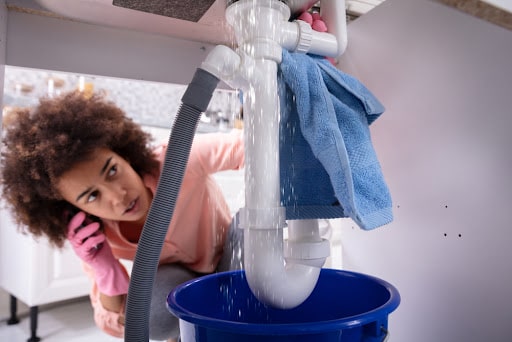
As a homeowner or property owner, property damage claims are a reasonable concern. That said, there are preventative steps you can take to protect your property based on the insurance strategy you choose.
Nearly half of all homeowners insurance claims are due to wind and hail—45.5% in 2020—but a variety of other problems also cause frequent homeowners claims.
We’ll explore the most common types of property damage claims and why property insurance is a necessary component of comprehensive coverage.
1. Wind And Hail
Wind and hail are some of the most common types of property damage claims. About 1 in 35 homes will make a wind or hail property damage claim this year.
The causes for these claims include fallen trees, broken windows, damaged siding, and other damages to homes as a result of high winds and hail storms.
How To Prevent Wind And Hail Damage Claims
To start, make sure you anchor large outdoor items such as grills and patio furniture to prevent them from potentially becoming airborne projectiles during wind storms.
Also, check your roof for loose shingles on a regular basis, and immediately repair any roof damage. You should also trim tree limbs to prevent overhang near your property and be wary of dead trees, which are more prone to snap and fall during wind storms.
2. Fire And Lightning
Although fire and lightning only account for 23.8% of property insurance claims, they are by far the most expensive claim, costing an average of $77,340 per claim.
Lightning strike and wildfire damage is relatively rare with 1 in every 385 homes filing a claim each year. Still, at that price point, you want to do everything in your power to prevent filing a fire or lightning damage claim.
How To Prevent Fire And Lightning Damage Claims
First, have a fire extinguisher on hand, especially in the kitchen. Nearly 50% of house fires start in the kitchen. Also, make sure to check smoke detectors every month. Replace batteries in smoke detectors regularly to ensure they are working properly.
You should also get into the habit of unplugging appliances during lightning storms to prevent power surges. Surges due to lightning are rare, but even with surge protectors (which are only meant to protect against small surges in the electrical grid), they can do serious damage with millions of volts of electricity.
For insurance protection against fire and lightning, guaranteed replacement cost coverage is your most comprehensive option. This insurance plan guarantees the full replacement value of your home in the event that it needs to be rebuilt due to serious fire or lightning damage.

3. Water Damage And Freezing
Water damage and freezing account for only 19.9% of property insurance claims, but they can cause severe damage as well. About 1 in 60 homes will file a water damage or freezing claim each year.
The most common causes of water damage and freezing are burst pipes and leaking roofs, which on average cost property owners around $12,000 to repair.
How To Prevent Water Damage And Freezing Claims
A basic first step to preventing water damage and freezing is to keep your gutters clean and use downspout extenders. Also, make sure gutters drain away from your home. Clogged gutters can cause water to flow directly to your basement, causing flooding and water leakage into the foundation of your property.
Raise appliances (washers, driers, and heavy electrical equipment) and valuables off of the floor whenever possible, especially in your basement. Finally, run your sump pump periodically and clean it each year before spring.
4. Bodily Injury
Although these incidents are more unusual, bodily injury claims are responsible for the second most expensive claim costs after fire and lightning at around $30,000 per claim. About 2% of property insurance claims are related to bodily injury liability.
How To Prevent Bodily Injury Claims
Be sure to keep walkways clear on your property—everything from salting your walkways and driveways to prevent slip and fall injuries, to clearing clutter from hallways and paths on your property.
Dog bites also account for ⅓ of homeowners’ liability claims, so keep an eye on your dog. Additionally, trampolines commonly lead to injuries and premium increases.
Umbrella coverage provides the most comprehensive coverage for bodily injury claims. With an umbrella plan, you’ll be covered against defense costs, judgments, and court costs relating to liability claims that take place on your property.
5. Theft
Fewer than .6% of property insurance claims are related to theft, and about 1 in 525 homes will file a theft-related claim each year. Average theft claims cost about $4,415 per claim.
How To Prevent Theft Claims
There’s no magic bullet solution to preventing theft. However, there are some preventive measures you can take to reduce your risk of property break-ins.
To start, strategic landscaping can help deter thieves. For example, you can place thorny bushes around first-story windows on your property. Next, don’t hide valuables in your primary bedroom. Most thieves will check a primary bedroom for valuables before other rooms in the house.
Finally, don’t post when you’re traveling ahead of time or during your vacation if you can help it. This one sounds a lot like the plot of Home Alone, but thieves can scope out unoccupied houses as targets, so wait until after your vacation to post those photos.
For the most comprehensive plan against theft, consider special personal property coverage. We recommend this coverage against theft, disappearance, and breakage for items whose value exceeds the limits of a standard insurance policy.
6. Medical Payment
About .3% of all property insurance claims are related to medical payments. These occur if a visitor to your property suffers an accidental injury, and you’re found liable to pay their medical expenses. Bills usually average around $7,000 for medical payment claims.
How To Prevent Medical Payment Claims
If you’re worried about medical payment liability, you should look into homeowners insurance with medical payments coverage. This coverage may include ER visits, hospital stays, surgeries, physical therapy, x-rays, ambulance rides, and funeral services in the event you’re found liable to pay someone’s medical expenses.

What Is Homeowners Insurance?
Homeowners insurance is what it sounds like: protection for your home. Standard homeowners insurance policies cover a wide variety of disasters. But what’s enough coverage?
You should have enough coverage to cover rebuilding costs in the event of property damage and the cost to replace personal items that could be lost or damaged. You should also make sure you’re protected in the event of a liability lawsuit.
To get a basic estimate of replacement cost, research local building costs per square foot and multiply that number by your property’s square footage. You can research these costs by contacting local real estate agents, builders, or insurance companies in your area.
There are different factors that affect homeowners insurance premiums, so you’ll want to do your research and reach out to experts if you have questions to find the right homeowners insurance plan for you.
What Types Of Property Damage Claims Does Homeowners Insurance Cover?
What does homeowners insurance cover? To answer this question, it might be helpful to review what homeowners insurance doesn’t cover. Generally, flooding, earthquakes, maintenance damage, and sewer backups are not covered.
While flood damage is excluded from standard homeowners and renters insurance policies, separate flood insurance can be purchased from the National Flood Insurance Program (NFIP) as well as from private insurers in some cases.
You can usually get earthquake insurance as a separate policy or an endorsement to your homeowners or renters insurance through your insurance provider.
Damage to your property due to lack of maintenance (e.g. mold, pest infestation) is considered your responsibility and is typically not covered by homeowners insurance.
Sewer backups are normally not covered by homeowners insurance or flood insurance. You can purchase sewer backup coverage as a separate product or as an endorsement to a homeowners policy.